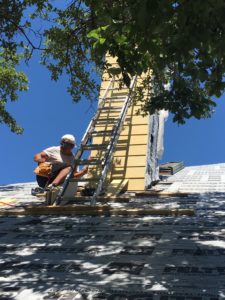 Quality siding can increase the value of your home while enhancing its curb appeal. However, if it is not installed correctly, even expensive siding can look cheap or fail to protect your home properly. Here are some common siding mistakes that can result in unsatisfactory results.
Quality siding can increase the value of your home while enhancing its curb appeal. However, if it is not installed correctly, even expensive siding can look cheap or fail to protect your home properly. Here are some common siding mistakes that can result in unsatisfactory results.
Installing New Siding Over Existing Siding
Although there are times when it is perfectly fine to install new siding without removing the existing siding, nailing new siding over the old can be a mistake. Removing the old siding reveals the studs so that any that are damaged or rotted can be repaired before the problem worsens. Depending on the siding materials involved, your existing siding can make your new siding appear wavy or uneven. Furthermore, the two layers of siding can lead to moisture becoming trapped, which can eventually lead to issues with mildew or mold.
Incorrect Nails or Nailing Patterns
Nails used for siding should be made from galvanized metal. Other types of nails can rust in a relatively short time, leaving ugly stains on your siding or decomposing to the point that your siding can become askew. Siding must be nailed securely, typically in locations that will be covered by the next course of siding. If the nails are driven too deeply, they can leave cavities that allow water to collect. If the nails are not driven deeply enough, water can follow the nail shaft and leak behind the siding.
Skimping on the Paint
Your siding protects your home from the elements; paint protects your siding. Low-grade paint or paint that is not formulated to withstand the weather can quickly begin to flake or peel. Once the integrity of the paint is compromised, water can begin to destroy your siding or reach the structural components of your home and damage them. Always choose an exterior paint that is of high quality. The same concept holds true if you are planning to stain or seal your wood siding.
Not Ensuring That the Courses Are Level
When installing siding, it is critical to make sure that every lap is horizontally level. Otherwise, the joints will not be sufficiently tight, allowing water penetration to occur.
Skipping the Vapor Barrier
HardieWrap Weather Barrier or a similar barrier should be installed beneath the siding to prevent moisture damage. Otherwise, your wall insulation and potentially the sheetrock in your home’s interior can be damaged.
Siding Is Too Near the Roof or the Ground
There should be at least a 2-inch gap between the top of the siding and the roofing material. Otherwise, runoff from the roof can exacerbate the wear on the siding. Ideally, this gap should be closed by filling it with steel or metal trim. Siding should be installed so that there is a gap of at least 6 inches between the bottom of the siding and the ground.
Ignoring Small Details
There are a number of seemingly small details that can have a big impact on the life of your siding. For example, if there are any exposed edges, they need to be painted or sealed. Dry caps should be installed at the top of doors and windows to guard against leaks. Paper seams or metal sheeting should be installed behind the joints in the siding. Doors and windows should be surrounded by an additional layer of flashing tape.
Not Choosing a Qualified Contractor
Of all the possible mistakes that homeowners can make, the most serious mistake is not hiring a reputable, qualified contractor to install their siding. Siding installation requires specialized tools, experience and training in the installation of the particular siding you have chosen, a willingness to address every detail and a commitment to providing quality workmanship.
Alpha Roofing is an Austin roofing contractor and we are dedicated to delivering exceptional work with professionalism, integrity and honesty. We install residential siding as well as asphalt shingles, skylights, and metal roofing systems. We also offer roof repairs, moss removal, roof inspections and chimney repairs. If you would like to receive a free quote, call us at (512) 777-1086 or fill out the online form.
